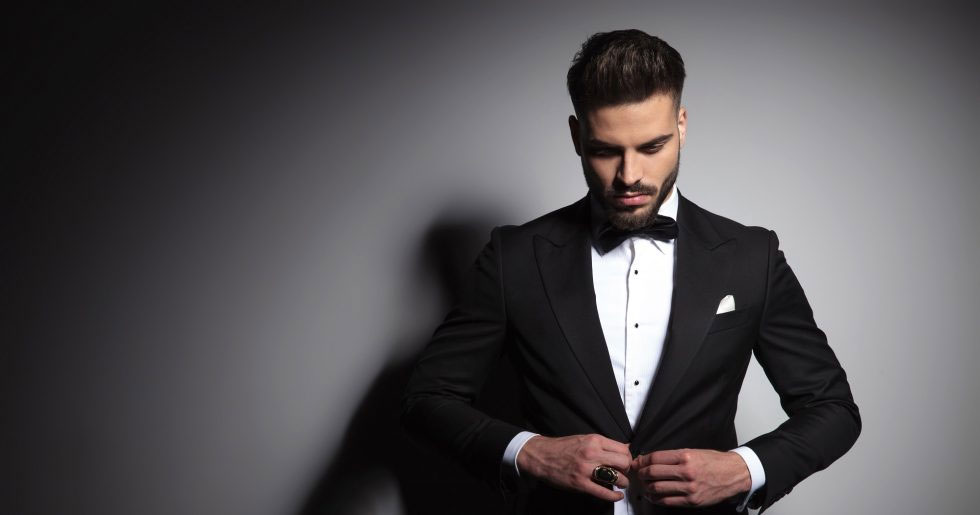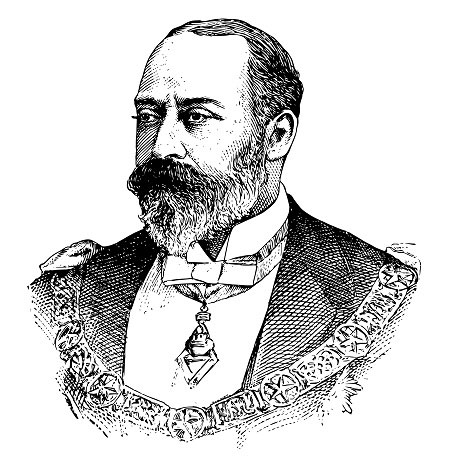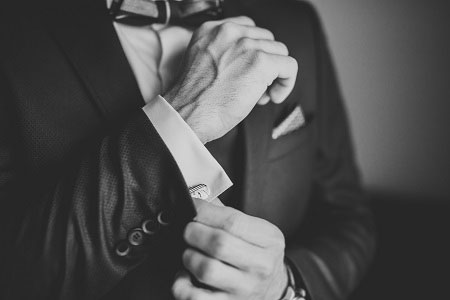
The tuxedo, we all have an image of one stored in our heads somewhere. The costume has come to exude smooth operators, classy performers, and debonair socialites throughout the ages. In some circles, it’s practically required to own one or have a few on retainer. In others, it strikes fear into the heart of the common man. With multiple components, a slim fit, and a seeming pressure to conform, it’s often surprising that this dinner jacket completely revolutionized formalwear and even scandalized popular culture multiple times over.
The Tuxedo Gallery is here to explore the history of the tuxedo, how it has come to define men’s fashion, and how certain actors have continued the trend or bucked conventions. Buckle in, because Fairfield’s favorite tuxedo rental company is about to become your new historian for this blog.
The Prince of Wale’s Dinner Jacket
The tuxedo suit has a disputed origin story. Named for Tuxedo Park in New York, even the name is disputed, with claims that it comes from Algonquin, Lenape or Dutch roots.
Most accounts always mention Griswold Lorillard first wearing the tail-less costume during the Tuxedo Club’s Autumn Ball in 1886, when tailcoats, white vests, and white ties were still considered in vogue. The tales that Lorillard stole his father’s tuxedo in an attempt to upstage and scandalize the event. As far as pranks go, it certainly was an alleged trendsetter.
Nowadays, modern historians credit the first tuxedo to King Edward VII.
They didn’t call it a tuxedo in 1865, however. The then Prince of Wales commissioned a new jacket and matching pants from Henry Poole and Co., his favorite tailor on Savile Row in London. While designed without tails, Poole still intended the suit for the Prince to use as an alternative to the smoking jacket for entertaining guests during casual dinners. To this end, the satin lapel was added.
So how did the dinner jacket go from Savile Row to Tuxedo Park? The answer lies in James Brown Potter; the millionaire saw the Prince in his dinner jacket during an event in 1885 and was curious. The Prince referred Potter to the (now late) Henry Poole’s tailoring shop. Instead of Griswold Lorillard stealing the suit from his father, it was James Brown Potter touting his regal style.
The dinner jacket instantly became a success and tailors reported clients asking for a dinner jacket “in the style of the ones they make in Tuxedo.”

Hollywood: The Tuxedo’s Breakout Role
After a sensational rise to prominence in the elite circles of New York magnates and socialites, the history of the tuxedo almost becomes a history of the film industry. During the early 1900s, formal wear was split between tuxedos and the classic tailcoat. By the Roaring Twenties, however, the tuxedo fell into disuse but saw a rise in popularity after the 1930s.
While countless actors would come to don the costume, its most famous wearer during the Great Depression was none other than Marlene Dietrich. She would don the auspicious outfit in Josef von Sternberg’s Morocco. Subverting gender norms, Dietrich took style tips from both men and women and rocked the suit on film and in public. Just chalk this as another reason to love this Golden Age icon.
Also, during the 1930s, the traditional tuxedo received a shakeup. Midnight blue tuxedos started to rival the more traditional black. In 1935 the total number of mills producing blue tuxedo wool outnumbered those producing black. By the 1940s, white tuxedos also became a fashion statement (as well as just being far more comfortable in warmer climates). Actors like Fred Astaire, Humphrey Bogart, Cary Grant, and more contributed to making the tuxedo into an image of class.
Bogart’s Rat Pack practically endorsed the tuxedo industry from 1950 onwards. But that was all about to change during the 1960s when a new tuxedo icon graced the silver screen: James Bond.
Changing Times, Changing Tuxedos

His secret? A fancy watch and a good tux. Turns out good style never goes out of style.
At the same time that James Bond was catching international criminals in style, however, fashion moguls were attempting to keep the dinner jacket contemporary. Tuxedos came to reflect the times they were created. Yves Saint Laurent reignited debates about gender norms by reinventing the style in his Fall/Winter Pop Art collection of 1966. Renamed “Le Smoking,” this brand of tuxedo was marketed to and for women.
Among other controversies, a most remarkable incident occurred when Nan Kempner was refused entry into Le Côte Basque club in New York City on the grounds that women could not wear pants. In an act of defiance, Kempner took off the pants and proceeded inside with just the blazer. “La plus chic du monde,” as Saint Laurent called her, continued one of the core trends in the history of the tuxedo: rebellion.
In the 1970s, tuxedo styles were blown wide open with ruffled collars, lace shirts, bellbottom pants, big floppy bowties and an explosion of colors. All of it reflected a departure from the conservative style of the 1950s and early 1960s and represented changes in American values.
The Modern Era: Bringing Back The Tux
The revolution seemed destined not to last, however. Modern formal dress wear returned to more conservative styling in the 1980s as a result of the rampant experimentation from the preceding decade plus. In formal circles, the tux slowly fell out in favor of business suits. The 1990s and early 2000s in particular were a style desert.
Take a look at any NBA Draft class from the period, and one will find nothing but oversized business suits on already big bodies. But that’s not all she wrote re the tuxedo.
The classic tux entered a renaissance during the mid-2000s when prestige dramas set during famous periods in the history of the tuxedo became the model for primetime television and Hollywood blockbusters. TV series like AMC’s Mad Men and Baz Luhrmann’s Great Gatsby featured leading men like Jon Hamm and Leonardo DiCaprio respectively in the illustrious dinner jackets. Daniel Craig’s critically acclaimed turn at the prestigious James Bond role also confirmed the return of the tuxedo.
With the new era came new aesthetic ideas. While tuxedos maintain midnight blue and black, suits today are not just limited to the classic colours but have expanded to include purples, burgundies, greens, and more. Once again we turn to the latest NBA Draft, where young talents consistently coated themselves in fabulous colors, trimmings, and accessories.
Nowadays it seems the tuxedo will never go out of style, but that’s always the case with fashion: what’s old is new as trends continue to develop, redevelop and then redevelop again.
No Matter What’s in Style, The Tuxedo Gallery is Here!
The history lesson is over! So let’s go right to it: if history has proven one thing, it’s that the tuxedo can be customized to your style. It’s less about the colors and the pants trim and more about maintaining the core pieces of a tuxedo. From there you can style and accessorize as need be. But if you’re not ready to splurge on a suit, that’s where The Tuxedo Gallery of Santa Rosa comes in.
We have served residents of communities like Fairfield in need of tuxedo rental for over 50 years. Our selection goes through time to bring you the best of the best. Find your inner style icon at the Tuxedo Gallery, be it in-store, online, or via the phone. Contact us today!
Tags: tuxedo fitting fairfield, tuxedo history, tuxedo rental, tuxedo rental fairfield, tuxedo services fairfield, tuxedos fairfield
